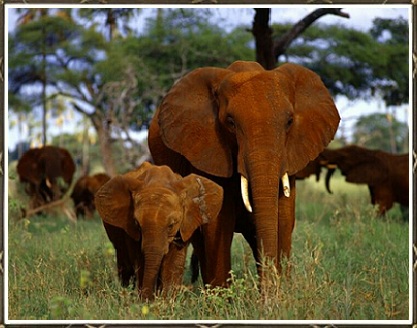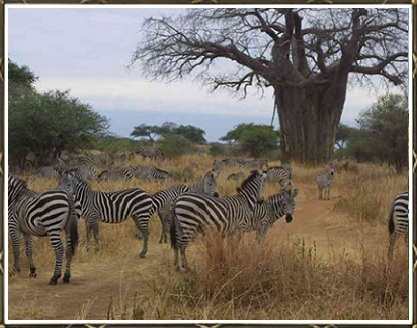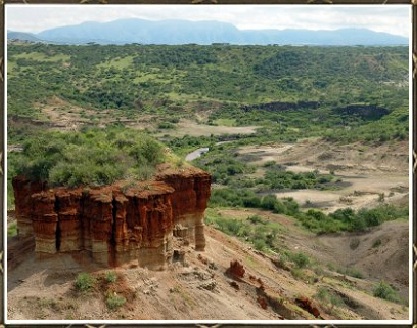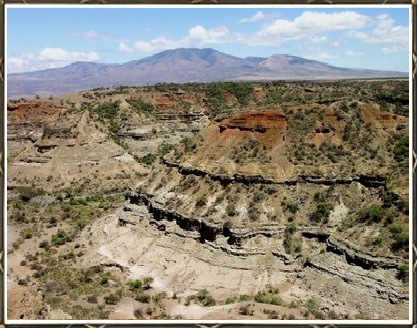The game parks of the Northern Circuit contain some of the most spectacular concentrations of wildlife found in Tanzania. It is no wonder that these game parks are world renowned, unparalleled in concentrations of wildlife, and some of the most pristine yet easily accessible biospheres left on earth.
Lake Manyara National Park
AREA: 319 Sq. Km.
ALTITUDE: 945 meters
Although it is Tanzania's smallest park, Lake Manyara is one of the most diverse reserves in the country. The beautiful Lake Manyara covers two thirds of the park, while the rest consists of steep mountainside, swamps, dense woodlands, open grassy areas and hot springs. Lake Manyara is one of the many alkaline lakes of the Great Rift Valley. It was formed about three million years ago and is quite shallow, with an average depth of about three meters. The lake attracts hundreds of bird species. In high vegetation near the park entrance, baboons and black monkeys charter between cicadas shrills. More than 350 species of birdlife are found in Lake Manyara - including pelicans, Egyptian geese, ducks, waders, herons, storks, grebes, ibises, kingfishers and the flamingoes. The extraordinary birdlife has made this place world-renowned among ornithologists; The Park is famed for its unique tree-climbing lions. The rare sight of seeing the king of the beasts sprawled in the bough of a tree is an unforgettable sight. The wall of the Great Rift Valley forms the backdrop before which lies the ground water, forest, areas of open grassland near the lake foreshore, and the Soda Lake.


Serengeti National Park AREA: 14763 Sq. Km.
ALTITUDE: 1400 Meters The Serengeti National Park is as big as Northern Ireland, and the most popular wildlife sanctuary in the world. It has been a protected area since the 1940's, and was accorded national park status in 1951. In 1981, the Serengeti was inscribed onto the list of UNESCO world heritage sites. The park is fantastic in its natural beauty and unequaled in its scientific value. This vast expanse of land is known to contain about 4 million different types of animals. The plains of the Serengeti are mainly crystalline rocks overlain by volcanic ash with numerous granitic rock outcrops (kopjes). In the north and along the western corridor are mountain ranges of mainly volcanic origin. Two rivers flowing west usually contain water and there are a number of lakes, marshes, and waterholes. Large herds of antelope of all sorts including: Patterson's eland, Klipspringer, Dikdik, impala, Zebra, gazelles, water, bush and reed buck, topi, kongoni, cotton's oribi, gray bush duiker, roan antelope buffalo, and wildebeest. Plus: lion, leopard, cheetah, hyena, bat eared fox, hunting dog and jackal. Smaller mammals: spring hare, porcupine, warthog, hyraxes, baboon, vervet monkey, colobus monkey, patas monkey, and mongooses. Larger mammals: giraffe, rhino, elephant, hippopotamus. Nearly 500 species of bird, including vultures, storks, flamingoes, martial and fish eagles, ostrich. Reptiles: crocodiles, a number of species of snakes and lizards The following statistics of wildlife population are a small indication of the immensity of the Serengeti: 700,000 Thompson gazelles, 65,000 Topi, 50,000 Grant gazelles, 1,500,000 wildebeest, 200,000 zebras, 2,000 lions, 800 leopards, 4,000 hyenas, 200 wild dogs, 500 cheetahs, 500 species of birds, more than 30 species of large herbivores...The list goes on. In May and early June you can witness the annual migration of millions of zebra and wildebeest in search of water and forage as the seasons change. Vegetation: Serengeti's low vegetation means that game viewing is relatively easy. It varies from open grass plains in the south, savannah with scattered acacia trees in the center, hilly, wooded grassland in the south, to extensive woodland and black clay plains in the west. There are many small rivers, lakes and swamps scattered about. Animals live in absolute freedom on the endless plains.


Tarangire National Park AREA: 2600 Sq. Km.
ALTITUDE: 1100 Meters. Tarangire is situated on the south of large open grass plains of southern Masailand. The name Tarangire is derived from the Tarangire River, which provides permanent water for wildlife. During the dry season, Tarangire has a high concentration of wildlife, second only to Ngorongoro Crater. Animals found in Tarangire, include lion, leopard, Oryx, gnu and greater and lesser kudu. Also included are: wildebeest, zebras, Thompson's gazelle, Grant's gazelle, buffalo, elephant, impala, and eland. Over 300 species of birds are recorded in the park. Some Eurasian migrants are found, which are present from October - April. Tarangire is an ornithologists paradise rich in birds of prey and an incredible diversity of fauna Vegetation: Principal features are the grassland and flood plains which consist of open grassland, acacia trees, rich woodland, found besides tributaries and orchard bush. This park is symbolised by the Baobab tree, dotted throughout the park growing in open acacia woodland


Arusha National Park AREA: 137 Sq. Km.
ALTITUDE: 1500 Meters (at Momella) Arusha National Park is a relatively small park; covering an area of 137 square kilometers (52.9 square miles) Lying between the peaks of Kilimanjaro and Meru, Arusha National Park is an area of outstanding beauty. The Park has a wide range of habitats, from the string of crater lakes where many water birds can be watched, through the highland Montane forest and on up to the imposing summit of Mt. Meru. The interesting geology of the area is reflected in the impressive view of the ash cone and cliff face leading to the summit of Mt. Meru. Three distinct areas are to be found within Arusha National Park: Ngurdoto Crater, the Momela Lakes and the rugged Mt. Meru. Altitudes range from 1,500 meters (4,921 feet) above sea level at Momela to over 4,500 (14,764 feet) meters at the summit of Meru. The Ngurdoto Crater is 20 Km. Across and 100 meters deep. The Momella Lakes 10 Km. North of Ngurdoto Crater, were formed about 1/4 million years ago, perhaps when Mt. Meru exploded and spewed volcanic debris and liquid mud over the surrounding area.The vegetation which occurs in the Park is correlated to the altitude and geology of the area. Ngurdoto Crater is surrounded by forest whilst the crater floor is a swampy area. The Momela Lakes, like many in the Rift Valley, are alkaline, and Mt. Meru is a mixture of lush forests and bare rocks. The forests contain a wealth of birds and other animals, like the beautiful bushbuck easily glimpsed in the grades between the ancient cedar trees, or the black and white colobus monkeys climbing along their branches. Other animals found in the park include buffalo, hippo, reedbuck, waterbuck, elephant, giraffe, baboon, bush pig, Sykes monkey, vervet monkey, mongoose and warthog. Birdlife includes grebe, African Pochard, ibis, heron and egret, both Mount Kilimanjaro and Mount Meru can be seen from the park when the weather is fine.


The Olduvai Gorge Olduvai Gorge is an archaeological site located in the eastern Serengeti Plains. The gorge is a steep sided ravine roughly 30 miles long and 295 ft deep, exposed deposits show rich fossil fauna, many hominid remains and items belonging to the one of the oldest stone tool technologies. The time span of the objects recovered date from 15,000 years ago to over 2 million years ago. In 1959 the skull of zinjanthropus was discovered by Dr. Leakey at the Olduvai Gorge. zinjanthropus was believed to have lived 1.8 million years ago. In the 1970's the footprints of animals and early hominids dating back to 3.5 million years were found by Mary Leakey at Laetoli, some 45 kms south of Olduvai Gorge. In 1974 fossils of hominid tooth were discovered, dating back to 2.4 million years. Engaruka Site discovered not very far from Olduvai is believed to be an ancient settlement of a later civilization. Between half a million and a million years ago, 'Homo Erectus, who stood upright, wandered around making use of hand axes. Many such tools were found at Olduvai. Skeletal remains of hominids on the old bed of the gorge are assigned to the Homo Habilis an Australopithecus Boisei family. Campsites and what is believed to be a butchery site have also been excavated from this bed. The Hominid living sites in Bed are found mainly where streams from the volcanic highlands carried fresh water to Olduvai Lake. The conditions for the preservation of the sites are mainly due to the ash falls from the nearby volcanoes. The debris found at the sites is various tools, bone and teeth of animals, mainly from a fair sized antelopes. Also a loosely built circle of lava blocks was found, suggesting that crude shelters were formed here as well. The latest of the archaeological Beds is the Naisiusiu. It lies in the bottom of the Gorge in what is now the present depth. It only has a depth of 33 ft. It contains one site that has microlithic tools and one complete Homo Sapien skeleton, both of which date to 17,000 years ago. More than 150 different species of extinct mammals have been identified from the fossils, as well as many birds, reptiles, amphibians and fish. An on-site museum explains the archeological significance of the discoveries. This area, it seems, is indeed the 'Cradle of Mankind'. The Annual Migration One of the most unique and remarkable scenes is the annual migration. Usually in May/June, thousands of wildebeest, giraffe, zebra, gazelle and buffalo migrate from the central plains westwards or northwards in search of water and pasture. One column turns to the north while another column turns to the west, later turning eastwards to join the northern column. Then, together the whole herd finally returns to the central plains, completing the circle. Over 1000kms are thus covered. As the herds move to new grazing ground, they are followed by predators such as lions, hyenas, jackals and hunting wild-dogs waiting for weak prey while vultures soar overhead waiting for their share of the kill. Best time for visiting is December - May when the animals gather on the short grass plains south of the park around Ndutu and Naabi Gate, dispersed and moving back and forth in search of water and fresh grass until the end of the long rains. Calving takes place in February/March, when 90% of female wildebeest, give birth flooding the plains with thousands of young ones. In May, when the plains begin to dry up, the wildebeest, together with other animals begin the long track westwards or northwards, once again. The migration involves between 500,000 - 1,000,000 animals out of the 4,000,000 found in the Serengeti


